Raabe J. Hydro power - the design, use, and function of hydromechanical, hydraulic, and electrical еquipment
Подождите немного. Документ загружается.

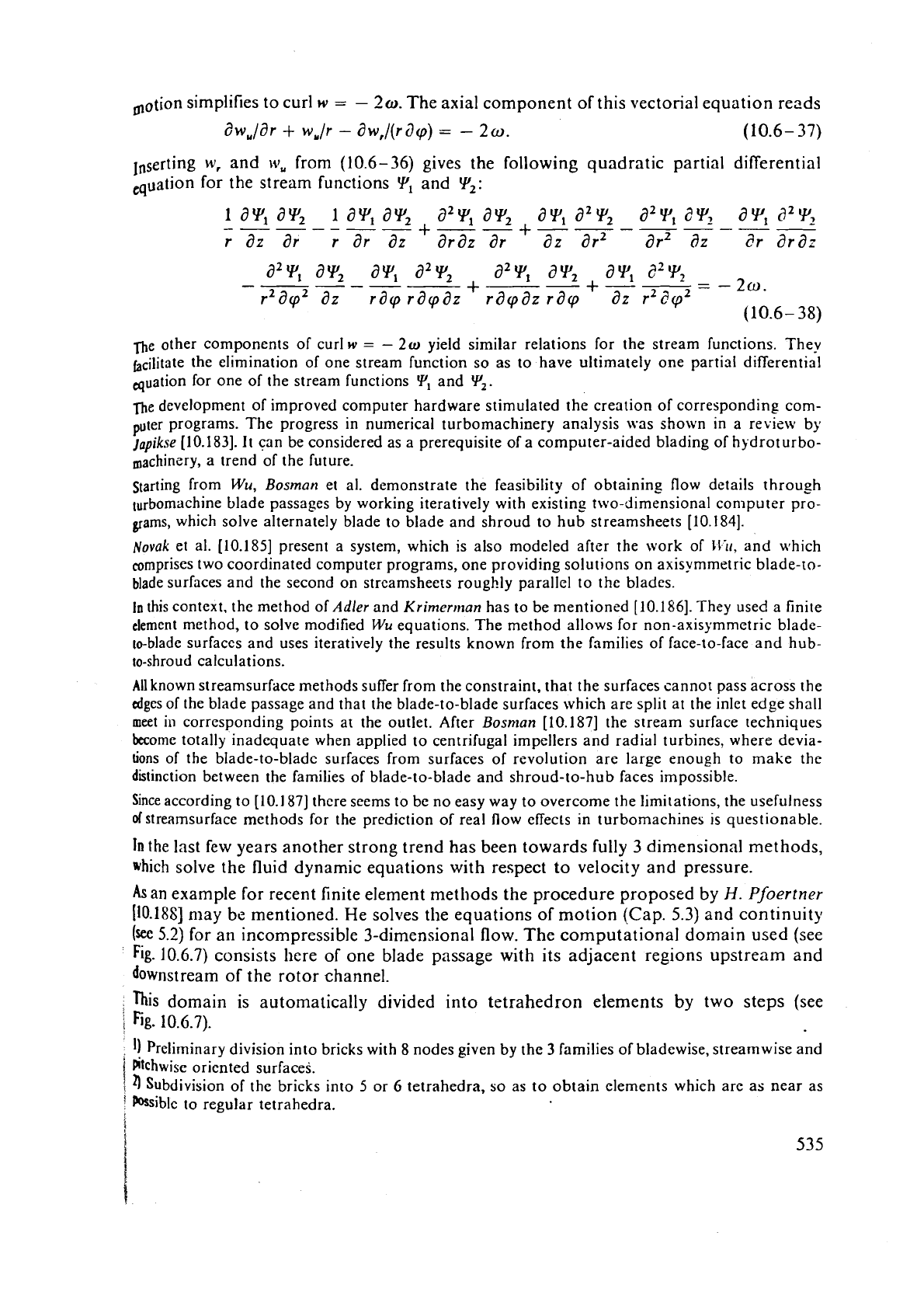
flotion simplifies to curl
w
=
-
201.
The axial component
of
this vectorial equation rer?ds
Inserting
w,
and
w,
from (10.6-36) gives the following quadratic partial differential
fluation for the stream functions
Yl
and
Y2:
fie other components of curl
w
=
-
2w
yield similar relations for the stream functions. They
facilitate the elimination of one stream function so as to have ultimately one partial differential
quation for one of the stream functions
Yl
and
Y2.
fie development of improved computer hardware stimulated the creation of corresponding com-
~uter programs. The progress in numerical turbomachinery analysis was shown in a review by
lopikse
(10.1831. It can be considered as a prerequisite of a computer-aided blading of hydroturbo-
a trend of the future.
Starting from
Wu,
Bosman
et al. demonstrate the feasibility of obtaining flow details through
turbomachine blade passages by working iteratively with existins two-dimensional computer pro-
grams, which solve alternately blade to blade and shroud to hub streamsheets
[10.184].
Novak
et al. (10.1851 present a system, which is also modeled after the work of
ll,ir,
and which
comprises two coordinated computer programs, one providing solutions on
axisymmetric blade-to-
blade surfaces and the second on streamsheets roughly parallel to the blades.
In
this context. the method of
Adler
and
Krimertnan
has to be mentioned [10.186]. They used a finite
clement method, to solve modified
Wu
equations. The method allows for non-axisymmetric blade-
to-blade surfaces and uses iteratively the results known from the families of face-to-face and hub-
to-shroud calculations.
All known streamsurface methods suffer from the constraint, that the surfaces cannot pass across the
edges of the blade passage and that the blade-to-blade surfaces which are split at the inlet edge shall
meet
in corresponding points at the outlet. After
Bosnlan
[10.187] the stream surface techniques
become totally inadequate when applied to centrifugal impellers and radial turbines, where devia-
lions of the blade-to-bladc surfaces from surfaces of revolution are large enough to make the
distinction between the families of blade-to-blade and shroud-to-hub faces impossible.
Since according to
[10.187] there seems to be no easy way
to
overcome the limitations, the usefulness
of
streamsurface methods for the prediction of real flow effects in turbomachines is questionable.
In
the
last few years another strong trend has been towards fully 3 dimensional methods,
which solve the fluid dynamic equations with respect to velocity and pressure.
As
an example for recent finite element methods the procedure proposed by
H.
Pfoertner
[10.188]
may
be
mentioned. He solves the equations
of
motion (Cap. 5.3) and continuity
(see
5.2)
for an incompressible 3-dimensional flow. The computational domain used (see
Fig.
10.6.7) consists here of one blade passage with its adjacent regions upstream and
downstream of the rotor channel.
,
nis
domain is automatically divided into tetrahedron elements
by
two steps (see
i
Fig.
10.6.7).
1)
Preliminary division into bricks with
8
nodes given by the
3
families of bladewise, streamwise and
pitchwise oriented surfaces.
!
9
Subdivision
of
the bricks into
5
or
6
tetrahedra, so as to obtain elements which are as near as
Possible to regular tetrahedra.
1
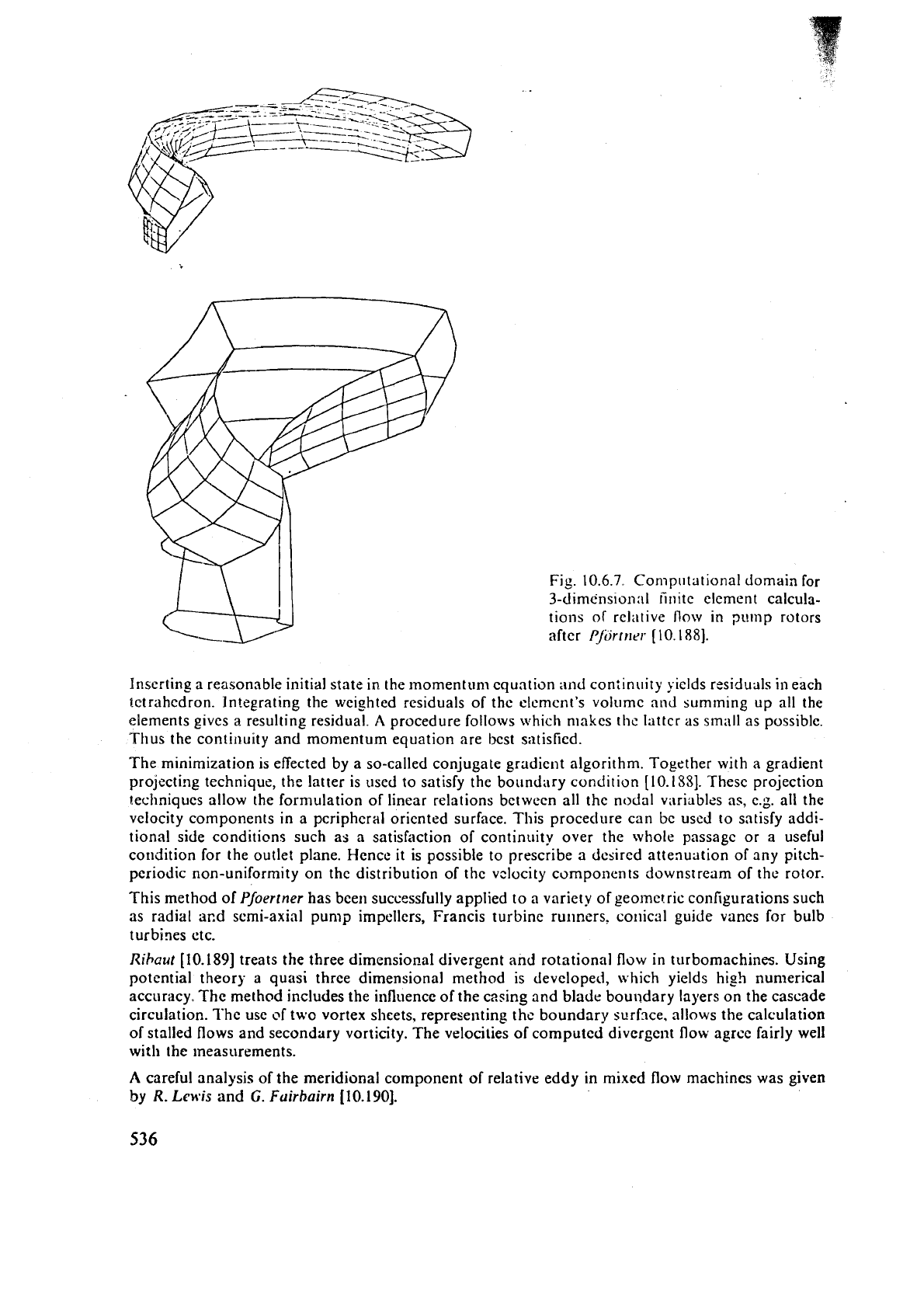
Fig.
10.6.7.
Coniputational domain for
3-dimc'nsio11:il
finite
element calcula-
tions
of
rclntive flow in
pump
rotors
after
P'rtnrr.
[lo.]
881.
Inserting a reasonable initial state in the momentum equation and coniinility yields residuals in each
tetrahedron. Integrating the weighted residuals of
thc elcrncnt's volume and summing up all the
elements gives
a
resulting residual.
A
procedure follows which makes
the
luttcr as small as possible.
Thus the continuity and momentum equation are best
satisfied.
The minimization
is
effected by a so-called conjugate gradient algorithm. Together with
a
gradient
projecting technique, the latter is used to satisfy the
boundiiry condition
[10.188].
These projection
techniques allow the
fornlulation of linear Ktshs betmen
aWc
ncxfsl variables as, e.g. all the
vclocity components in a peripheral oriented surface.
This procedure can bc used to satisfy addi-
tional side conditions such
as a satisfaction of continuity over the whole passagc or a useful
corldition for the outlet plane. Hence it is possible to prescribe a dcsircd attenuation of any pitch-
periodic non-uniformity on thc distribution of the velocity components downstream of tho rotor.
This method of
Pjbertner
has been successfully applied to a variety
of
geometric configurations such
as radial
ar,d
scmi-axial punlp impellers, Francis turbine runners. coliical guide vanes for bulb
turbiges etc.
Ribcut
[lo.
1891
treats the three dimensio~al divergent and rotational flow in turbomachines. Using
potential theory a quasi three dimensional
method is
developed,
which yields high numerical
accuracy. The method includes the influence of the casing and blade boundary layers on the cascade
circulation.
l'hc usc of two vortex sheets. representing thc boundary surf:~ce. allows the calculation
of stalled flows and secondary vorticity. The velocities of
computcd divergent flow agrce fairly well
wit11 the measurements.
A
careful analysis of the meridionai component
of
relative eddy in mixed
flow
machines was given
by
R.
Lcwis
and
G.
Fuirhairn
[10.190].
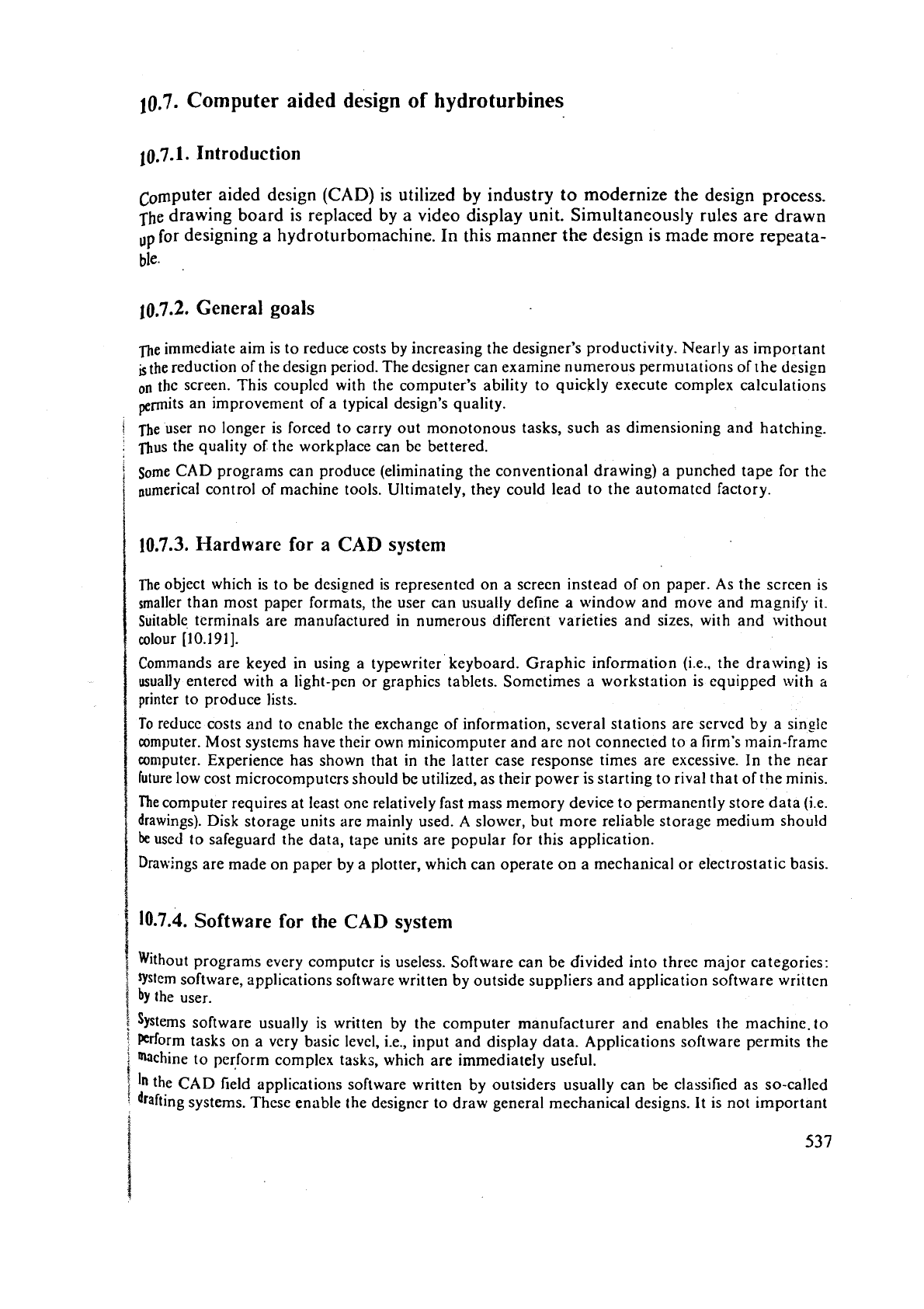
10.7.
Computer aided design of hydroturbines
10.7.1. Introduction
computer aided design
(CAD)
is utilized by industry to modernize the design process.
The
drawing board is replaced
by
a video display unit. Simultaneously rules are drawn
up
for designing a hydroturbomachine. In this manner the design is made more repeata-
ble.
10.7.2. General goals
The immediate aim is to reduce costs by increasing the designer's productivity. Nearly as important
is
the reduction of the design period. The designer can examine numerous permutations of the design
on
the screen. This coupled with the computer's ability to quickly execute complex calculations
an improvement of a typical design's quality.
The user no longer is forced to carry out monotonous tasks, such as dimensioning and hatching.
~hus the quality of the workplace can be bettered.
Some
CAD
programs can produce (eliminating the conventional drawing) a punched tape for the
~lumerical control of machine tools. Ultimately, they could lead to the automated factory.
10.7.3. Hardware for a
CAD
system
The object which is to be designed is represented on a screen instead of on paper. As the screen is
smaller than most paper formats, the user can usually define a window and move and magnify
it.
Suitable terminals are manufactured in numerous different varieties and sizes, with and without
colour
[10.191].
Commands are keyed in using a typewriter keyboard. Graphic information (i.e., the drawing) is
usually entered with a light-pen or graphics tablets. Sometimes a workstation is equipped with
a
printer to produce lists.
To reduce costs and to enable the exchange of information, several stations are served
by
a single
computer. Most systems have their own
n~inicomputer and are not connected to a firm's main-frame
computer. Experience has shown that in the latter case response times are excessive. In the near
future low cost microcomputers should be utilized, as their power is starting to rival that of the minis.
The
computer requires at least one relatively fast mass memory device to permanently store data (i.e.
drawings). Disk storage units are mainly used.
A
slower, but more reliable storage medium should
be
used to safeguard the data, tape units are popular for this application.
Drawings are made on paper by a plotter, which can operate on a mechanical or electrostatic basis.
10.7.4.
Software for the
CAD
system
Without programs every computer is useless. Software can be divided into three major categories:
Vstem software, applications software written by outside suppliers and application software written
by
the user.
!
Systems software usually is written by the computer manufacturer and enables the machine. to
i
Perform tasks on a very basic level, i.e., input and display data. Applications software permits the
!
machine to perform complex tasks, which are immediately useful.
1
the
CAD
field applications software written by outsiders usually can
be
classified as so-called
drafting systems. These enable the designer to draw general mechanical designs. It is not important
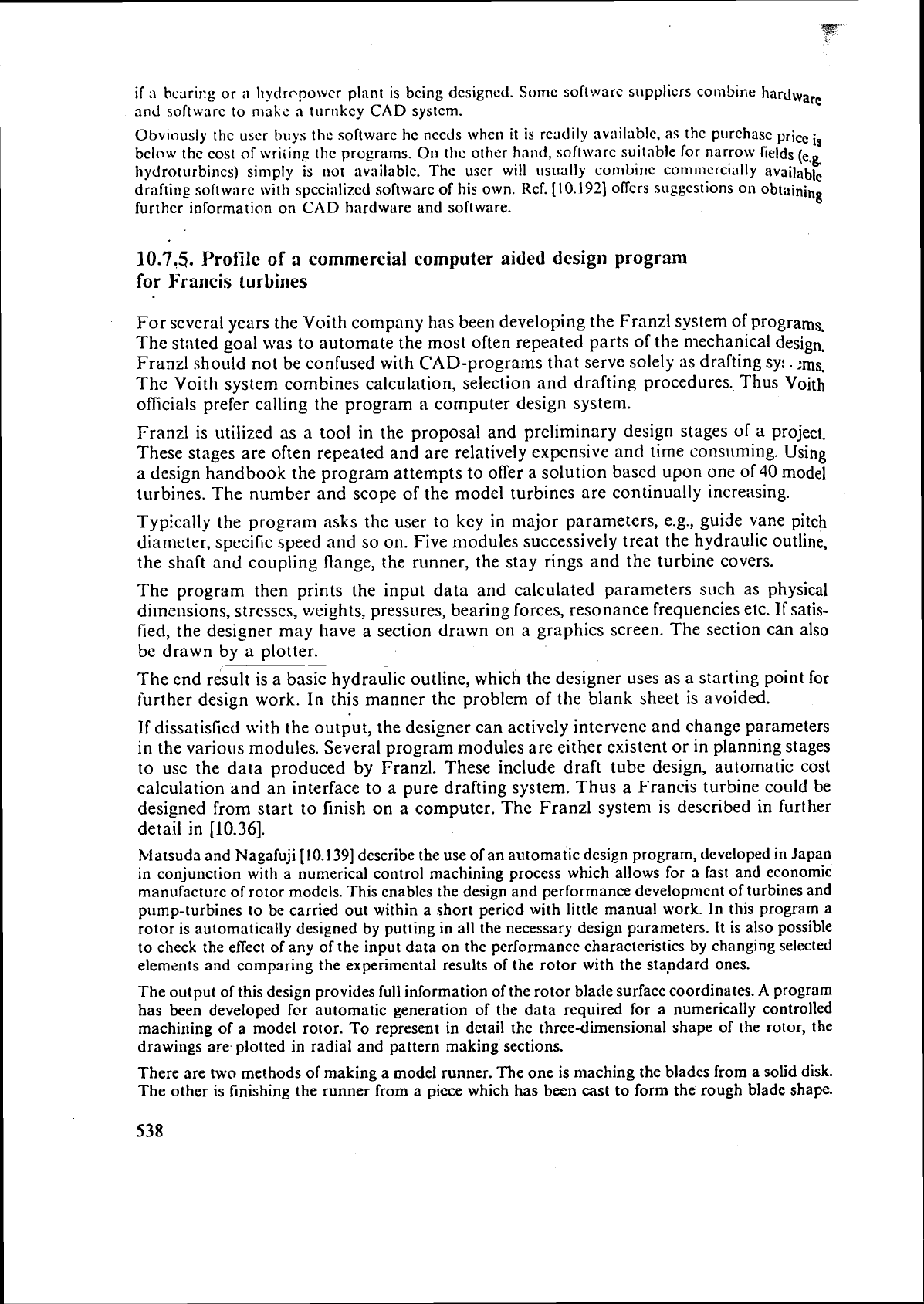
if
:I
bearing or
a
hydrcpowcr plant is bcing dcsigncd. Somc softwarc
suppliers
combine hardware
and softwarc to
makc
a turnkcy
CAD
systcm.
Obviously thc user buys thc softwarc hc nccds whcrl
it
is rcactily ;~vailablc, as thc pt~rchase
price
is
bclnw the cost of wriiing the programs.
On
thc other hand, softwarc suitable for narrow fields
(
hydroturbincs) simply is not available. Thc user will usually combinc
commercially
available
drafting sofiwarc with spcci;~lizcd software of his own. Rcf. [10.192] offcrs soggcstions
011
obtaining
further information on
CAD
hardware and software.
10.7.5.
Profile
of
a
commercial computer
aided
design program
for
Francis turbines
For several years the Voith company has been developing the Franzl system of programs.
The stated goal was to automate the most often repeated parts of the mechanical design.
Franzl should not be confused with CAD-programs that serve solely as drafting sy:
.
:ms.
The Voith system combines calculation, selection and drafting procedures. Thus Voith
officials prefer calling the program a computer design system.
Franzl is utilized as a tool in the proposal and preliminary design stages of a project.
These stages are often repeated and are relatively expensive and time consnming.
Using
a
design handbook the program attempts to offer a solution based upon one of
40
model
turbines. The number and scope of the model turbines are continually increasing.
Typically the program asks the user to
key
in
major parameters, e.g., guide var?e pitch
diameter, specific speed and so on. Five modules successively treat the hydraulic outline,
the shaft and coupling flange, the runner, the stay rings and the turbine covers.
The program then prints the input data and calculated parameters such as physical
di~nensions, stresses, weights, pressures, bearing forces, resonance frequencies etc. If satis-
fied, the designer may have a section drawn on a graphics screen. The section can also
be drawn by a plotter.
The
end result is
a
basic hydraulic outline, which the designer uses as a starting point for
iurther design work. In this manner the problem of the blank sheet is avoided.
If dissatisfied with the output, the
desizner can actively intervene and change parameters
in the various modules. Several program modules are either existent or in planning stages
to
usc the data produced by Franzi. These include draft tube design, automatic cost
calculation and an interface to a pure drafting system. Thus a Francis turbine could be
designed from start to finish on
a
computer. The Franzl system is described in further
detail in
[10.36].
hlatsuda and Nagafuji [10.139] dcscribe the use of an automatic design program, developed in Japan
in conjunction with a numerical control machining process which allows for
3
fast and economic
manufacture of rotor models. This enables the design and performance development of turbines and
pump-turbines to
be
carried out within a short period with little manual work. In this program a
rotor is automatically designed by putting in all the necessary design parameters. It is also possible
to check the effect of any of the input data on the performance
charactcristics by changing selected
elemcnts and comparing the experimental results of the rotor with the standard ones.
The output of this design provides full information of the rotor
blade surface coordinates.
A
program
has been developed for automatic
generation
of the data required for a numerically controlled
machining of a model rotor. To represent in detail the three-dimensional shape of the rotor, the
drawings are plotted in radial and pattern making sections.
There are two methods of making a model runner. The one is
nlaching the blades from a solid disk.
The
othcr is finishing the runner from
a
piece which has been cast to form the rough blade shape.
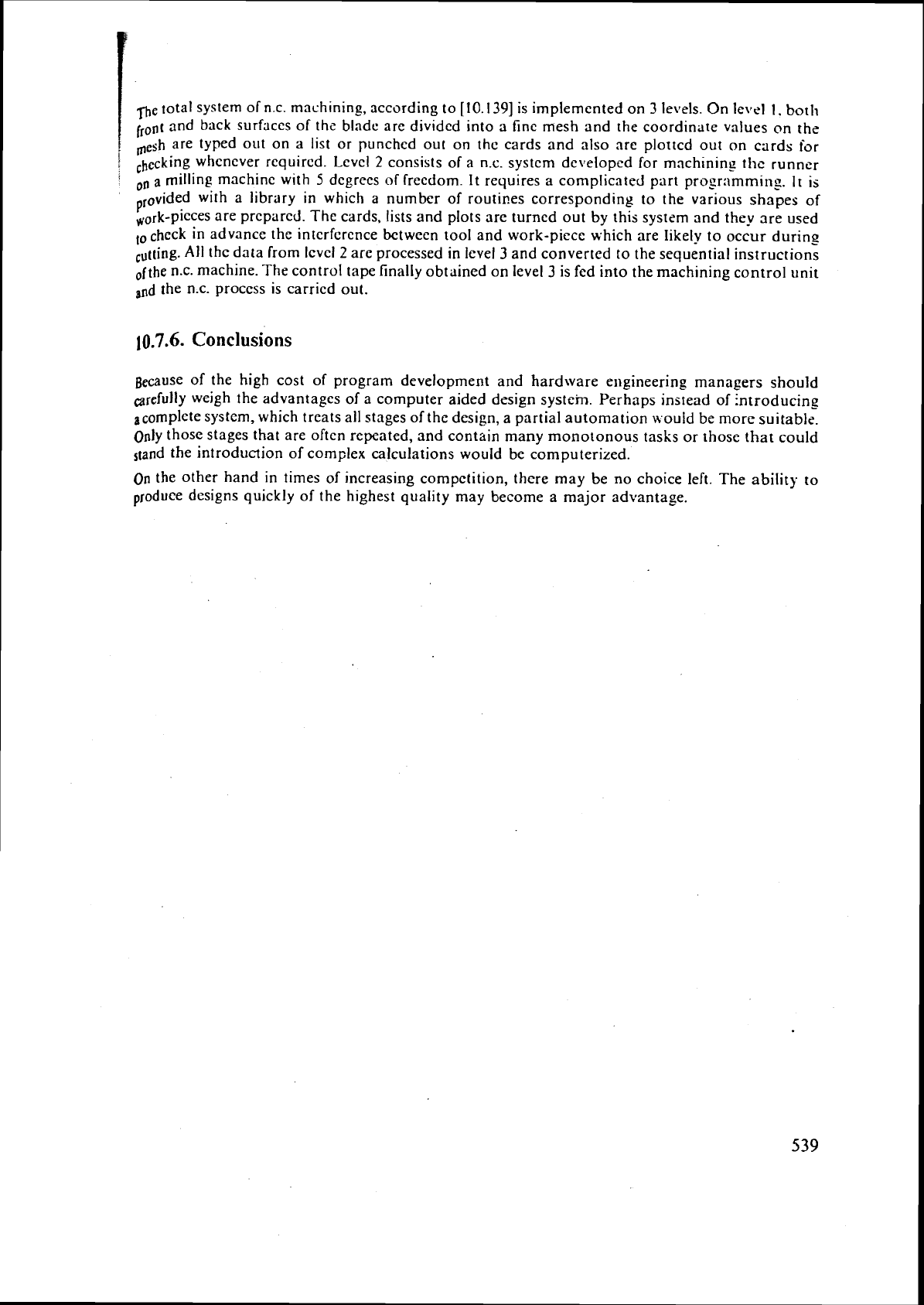
fie
total system of n.c. machining, according to
[10.139]
is implemented on
3
levels. On level
1.
both
front and back surfaces of the blade are divided into a fine mesh and the coordinate values on the
lIlesh
are typed out on a list or punched out on thc cards and also are plotted out on cards tjr
checking whenever required. Level
2
consists of a n.c. system developed for machinin the runner
on
a
milling machine w~th
5
degrees of freedom.
It
requires a complicated part programming.
It
is
rovided
with
a library in whlch a number of routi~es corresponding to the various shapes of
i0rtpieces are prepared. The cards, lists and plots are turned out by this system and they are used
to
check in advance the interference between tool and work-piece which are likely to occur during
cutting. All the data from lcvel
2
are processed in level
3
and converted to the sequential instructions
ofthe n.c. machine. The control tape finally obtained on level
3
is fed into the machining control unit
and the n.c. process is carried out.
10.7.6.
Conclusions
Because of the high cost of program development and hardware engineering managers should
weigh the advantages of a computer aided design system. Perhaps instead of introducing
acomplete system, which treats all stages of the design, a partial automation would be more suitable.
Only those stages that are oftcn repeated, and contain many monotonous tasks or those that could
stand the introduction of com~lex calculations would be computerized.
On the other hand in times of increasing competition, there may be no choice left. The ability to
designs quickly of the highest quality may become a major advantage.

11.-Regulation
of
hydro power
sets,
the
generator
1
1.1.
Introduction
The constant speed requirement of the usual hydro turbo set si~pplying an
AC
grid
by
means of a synchronous generator (the alternator) needs speed regulation, sometinle~
j,
connection with load distribution
and
load regglation.
011
the one hand thc control loop
used for this purpose irlcludes the governor with
a
device for metering the speed deviation
and
soriietimes also for metering the
acceleration,
and its servomotor for the load adjust-
n~ent of the turbine.
On the other hand, the control
lo~p includes slsc? the p!ant or the controlled system.
This
cor~sists of the hydro turbo set with the turbine and the alternator, its piping and the
electric grid connec:cd with it.
The
different meci~anical, hydraulic and electronic designs for metering the deviation of
speed
and
their features merit some considerations. The rather large controlling forces of
gates and
runncr vanes require oil-operated servomotors.
Their-
vnlvcs are actuated from
the
speedometer via relays by sleeve valves .x.ith their special linkage including feedback,
and
~nter-llnkii~g devices for different control loops at doublc
regulated
lnachines.
Tile
governor nceds devices to adjust the speed droop as
n
characteristic of the set, to limit
rl~e
gate opening. to set the damping of possible oscilli~tions in the control loop, and to
synchronize the set.
In this context
the condition; fur dynamic stabiiity
of
thz control loop have to be
considered. They
iticlude the incrtia of the set mainly due to its alternator and the
characterisiics due to certain loads of the supplied grid. Also the characteristics of the
turbine and of the pipe system with respect to water hammer and its boundary conditions
have to be accounted for.
For a proper
operiition, the individual time constailts for start
up
and shut down of the
structural
members of the plant such as penstock and set, have to be tuned to each other,
and also with respect to limit overspeed by fly-wheel effect.
The references
11
1.1 to
11.51
zive a matcrial survey of control due to hydro power, [I 1.61 brings
a
historical survey. The control of hydro power plants
in
general is treatcd in [11.7; 11.81, its stabilizing
p~oblems
in
[I
1.9
to
11,
131.
A
classilication of the governors is rnade
i11
[l
1.141,
the
load control, also
nith electronic devices, in
[11.15
to 11.191. the related power swing
in
(1
1.201.
Water level control
is
treated in [11.21; 11.221, self regulation in [11.23], the control of speed and
voltage
in
[1I.Z1].
The
dynarnic behaviour of the controlled system is generally investigated in
[I
1.251,
by means of frequency rcsponse curves
in
[I
1.26; 11.271, by stochastic signals in
[I
1.281. The
~latural frequencies of thc controlled systen~ are considered
in
j11.29;
11.301,
with
respect to the
boundary
conditiolls of
penstocks
in
[I
1.31;
11.32). and
with
respect to rock-bored penstocks in
[I
1.331.

Governing under transient load is reported in
[I
1.341,
the relevant damping factors are introduced
[I 1.351, non-linear solutions in [I 1.361, the simulation of a hydro power system in
[I
1.371. Gover-
oars
for small plants are described in [I 1.381, optinlization of control
by
electronic governing is
in [11.39], electric equipment of the turbine governor in [11.40]. motor and generator of
,he
speedometer
in [11.41], control by means of positive displacement pumps in
[l
1.421. electro
governors in [I 1.431, an electronic governor head in [I 1.441,
a
computerized
governor
in
[11.45], use of micro computers in [I 1.461, use of module techniques in [11.47] and that of
,+oprocessors in [I 1.481.
fie locking spring is introduced as a safety device in [I 1.491, recording instruments are presented
in
(11.501, the determination of the runner vanelgate vane interrelation in
(1
1.511, the emergency
dosing device in [11.52],
a
runaway speed limiter for Kaplan turbines in
(1
1.531. the regulating work
i
in
(11.541, the prediction of fly-wheel mass in
[I
1.551, the optimization of Pelton turbine governors
j
[11.56], the water column effect in speed control in [11.57]. the safe control of a by-pass outlet in
1
(11.581, and the starting up of a set in [11.59].
!
[
In
the field of control the technical terms in the follow text following mainly from the
English equivalents of the German Standards for automatic speed control technology
DIN
19229
DK
621
-53.
Traditional denotations of some terms (if any at all) are occasion-
ally
added in brackets for the orientation of the "old fellows".
i
The following text has been kindly revised by my colleague Professor Dr.
H.
Schmidt
with
respect to the proper use of control conceptions.
The
common treatment of regulation and generator in one chapter was made to keep
consecutive chapters in balance with respect to their length.
One joint fact between both members is the need for frequency control, when the genera-
tor feeds an
AC
grid as usual, another can be seen in the circumstance that, at excitation
unaltered, the alternator output increases linearly with frequency, and thus may change
by
regulation.
Usually the electric machine of the set is a generator of
AC,
an alternator. In pumped
storage and tidal power plants with special pumping, the alternator is also used as motor.
The alternator requires a special consideration. Contrary to the turbo generators of
thermal
szts, its number of pole pairs has to be adapted to the relatively small and widely
varying head.
This requires a salient pole design instead of the usual drum rotor, standardized for the
usual
therrnal turbo set.
Moreover the construction of the electric machine has to match the strongly varying
features
of
the hydraulic set, e.g., withstanding runaway, forming a structural unit togeth-
er
with turbine and generator especially in the case
of
a rim generator shrunk onto the
runner, and a critical operation
with respect to shaft vibration. Thus the design
of
shaft
and adjacent bearings is
concentra:ed on the effort to shift the lov~est critical speed to a
margin above runaway.
At
higher heads, the relative heavy electric rotor poses problems of low critical speed and
sufficient cooling.
1
In
primped
storage plants and tidal power plants with double effect, and equipped with
1
a
pump-turbine, the generator, then also used as motor, has to reverse its rotation
\
between the different modes of operation. Pole changing between pumping and turbining,
itarting up the filled or emptied machine into pumping either by synchronous operation
i
(back-to-back connections of neighbouring sets or thyristor-coxitrolled frequency),
asynchronous operation, or by
a
pony motor, pose problems of fatigue and heating ir, the
conductor.
I
t
54
1

Concerning the ref~rcnccs on the
set's
clcctric ni;~chinc.
;I
survey is prcqcntcd
in
[I
I
.hO;
11.611. l<cccll,
1.1rgc dc(ig11s
of
Hra,lll;in pl:~nts ;ire treated
111
[I
1.62],
and
iarzc s;lli~nt pole 1n;l~hin~s in
(1
1.631.
I~idividuiil constructions of altcrn;ltors ;~nd gcncrators ;ire co~~sidcrcd
111
1
I
l
.h1
to
1
1.661, i~ldu~~i~~
gcncrntors in
[I
1.671. motor gcncrators of pumped storage plants in [I
1.68
to 11.70j. qtochnstic loads
on the rotor in
[I
1.711. rcsonancc of torsion and
bending
v~brations
in
[I 1.721, currcnl-induccd
forces
in
[I 1.731, and resulting strcsscs in [I 1.741.
Cooling is trcntcd in
[I 1.75; 11.761, diflercnt c.xciting systclns in
(1
1.77; 11.781, the insulation problem
in
[I
1.791, the upruting of old macllincs
in
[I 1.801, rccent Japanese tcchrlology
in
[I
1.811, and recent
Wcsi German technology in [I 1.821.
The
f;llowing text has been kindly revised with respect to the proper use of electric
conceptions by
1Mr.
K.
V:
Wil1y;deputy director at Siemens Erlangen, West Germany.
11.2.
Regulation of hydro power sets, governors, accessories
11.2.1.
The
governor, its purposes, its design
11.2.1
.I.
Survey of control, different kinds,
why
specd control
In
water
power
plants the alternator output us~ially has to
be
adapted to the power
demand of the grid.
For
this purpose the output or such other values, which depend on
it,
e.g.,
the
speed, have to be measured continuously and to be adjusted to the demand.
The direct measurement
of
output exists in load control, which is usually combined with
specd control (Fig.
11.2.1
a)
(11.16;
11.17;
11.191.
Fig.
11.2.1.
Speed control in connection with that of other quantities. a) Combined power and speed
control
1
Wattmeter;
2
pilot servomotor;
3
combination lever;
4
speedometer;
5
main servomotor;
7 feedback.
b)
Combined speed and head control. 8 float on the head water pond;
9
speedometer;
10
combination lever;
1
1
servomotor; 12 valve;
13
feedback.
542
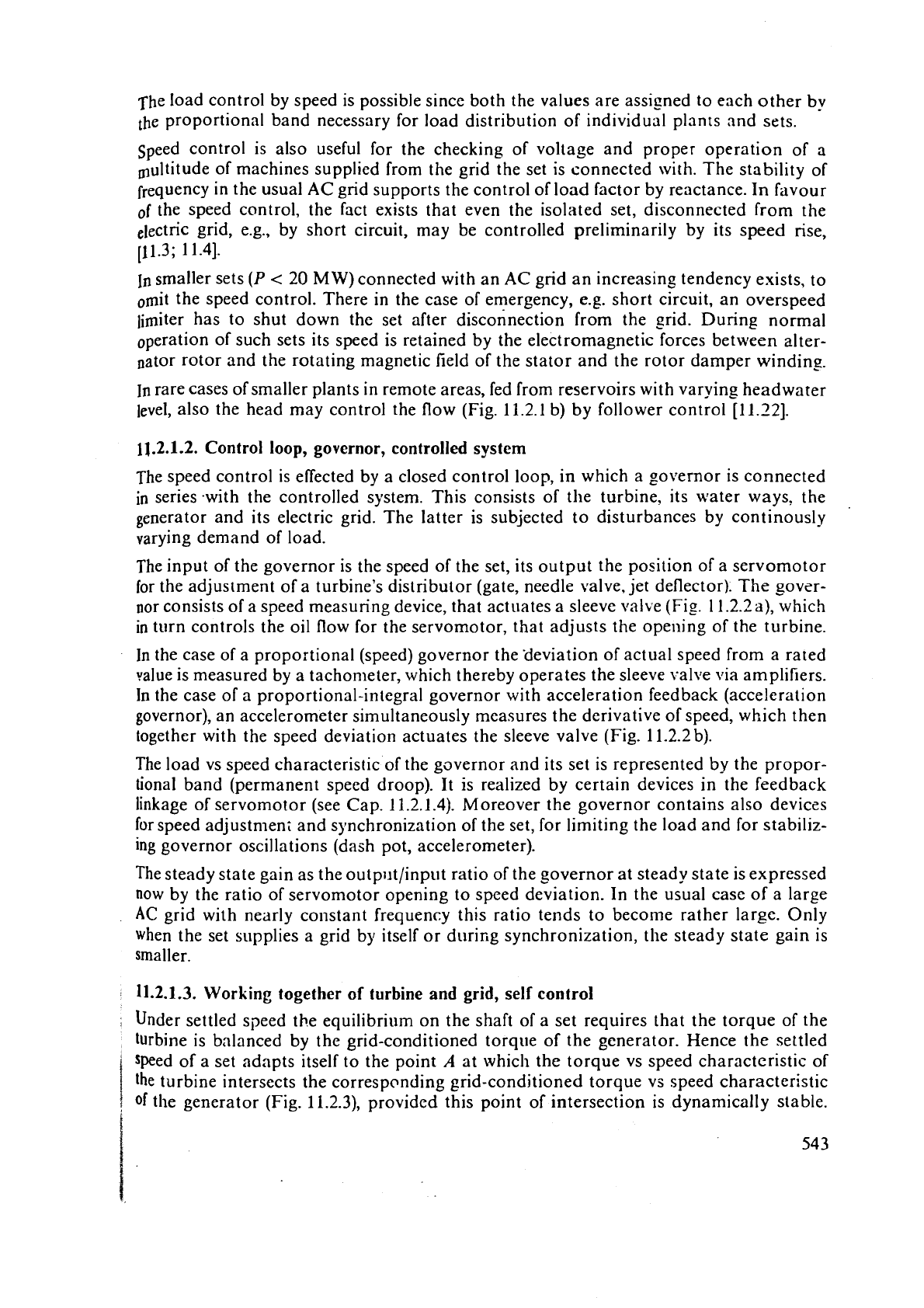
The load control by speed is possible since both the values are assisned to each other by
the proportional band necessary for load distribution
of
individual plants and sets.
speed control is also useful for the checking of voltage and proper operation of
a
multitude
of machines supplied from the grid the set is connected with. The stability of
frequency in the usual
AC
grid supports the control of load factor by reactance. In favour
of the speed control, the fact exists that even the isolated set, disconnected from the
grid,
e.g., by short circuit, may be controlled preliminarily by its speed rise,
p1.3; 11.41.
In
smaller sets
(P
<
20
MW)
connected with an
AC
grid an increasing tendency exists, to
ornit the speed control. There in the case of emergency, e.g. short circuit, an overspeed
limiter has to shut down the set after disconnection from the grid. During
normal
operation of such sets its speed is retained by the electromagnetic forces between alter-
nator rotor and the rotating magnetic field of the stator and the rotor damper
windins.
In rare cases of smaller plants in remote areas, fed from reservoirs with varying headwater
level, also the head may control the flow (Fig. 11.2.1 b) by follower control
[I 1-22].
11.2.1.2.
Control loop, governor, controlled system
The speed control is effected by a closed control loop, in which a governor is connected
in series .with the controlled system. This consists of the turbine, its water ways, the
generator and its electric grid. The latter is subjected to disturbances by continously
.
varying demand of load.
The input of the governor is the speed of the set, its output the position of a servomotor
for the adjustment of a turbine's distributor (gate, needle valve, jet deflector). The
govsr-
nor consists of a speed measuring device, that actuates
a
sleeve valve (Fig.
11.2.2a),
which
in turn controls the oil flow for the servomotor, that adjusts the opening of the turbine.
In the case of a proportional (speed) governor the 'deviation of actual speed from a rated
value is measured by a tachometer, which thereby operates the sleeve valve
via amplifiers.
In the case of a proportional-integral governor with acceleration feedback (acceleration
governor), an accelerometer simultaneously measures the derivative of speed, which then
together with the speed deviation actuates the sleeve valve (Fig.
11.2.2b).
The load vs speed characteristic of the governor and its set is represented by the propor-
tional band (permanent speed droop). It is realized by certain devices in the feedback
linkage of servomotor (see Cap.
11.2.1.4). Moreover the governor contains also devices
for speed
adjustmen; and synchronization of the set, for limiting the load and for stabiliz-
ing governor oscillations (dash pot, accelerometer).
The steady state gain as the
outp~lt/input ratio of the governor at steady state is expressed
now by the ratio of servomotor opening to speed deviation. In the usual case of a large
AC
grid with nearly coilstant frequency this ratio tends to become rather large. Only
when the set supplies a grid by itself or during synchronization, the steady state gain is
smaller.
11.2.1.3.
Working together of turbine
and
grid,
self
control
:
Under settled speed the equilibrium on the shaft of a set requires that the torque of the
turbine is balanced by the grid-conditioned torque of the generator. Hence the settled
speed of a set adapts itself to the point
A
at which the torque vs speed characteristic of
the turbine intersects the corresponding grid-conditioned torque vs speed characteristic
of the generator (Fig. 11.2.3), provided this point of intersection is dynamically stable.
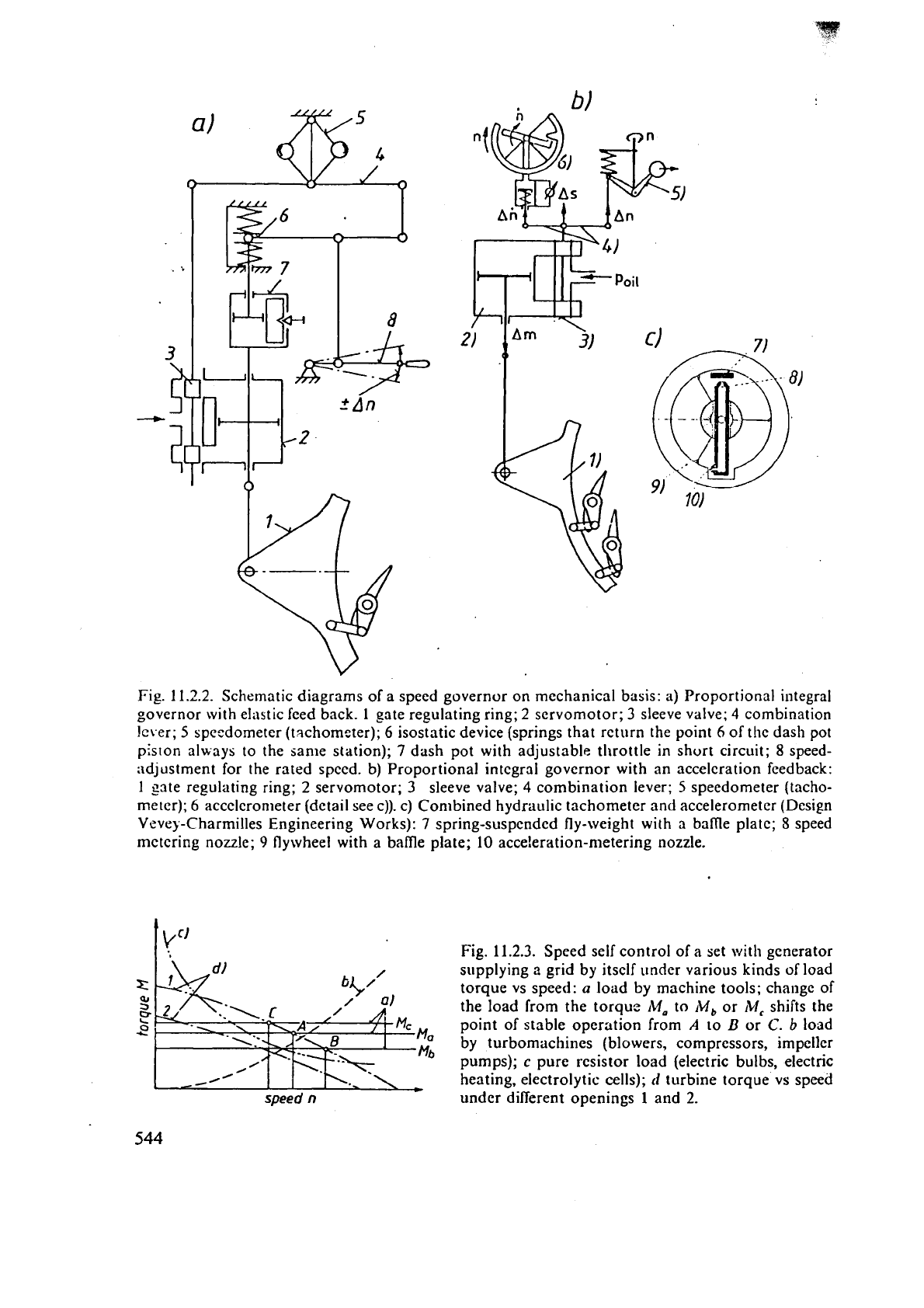
Fig.
11.2.2. Schematic diagrams of a speed governor on mechanical basis: a) Proportional integral
governor with elastic feed back. 1 gate regulating ring; 2 servomotor;
3
sleeve valve;
4
combination
!c\.er;
5
speedometer (tachometer);
6
isostatic device (springs that return the point
6
of the dash pot
pisron always to the same station);
7
dash pot with adjustable throttle in short circuit; 8 speed-
adjustment for the rated
spced. b) Proportional integral governor with an acceleration feedback:
1
sate regulating ring; 2 servomotor;
3
sleeve valve;
4
combination lever;
5
speedometer (tacho-
mew);
6
accelcrometer (detail see c)). c) Conibined hydraulic tachometer and accelerometer (Design
Vevey-Charmilles Engineering Works):
7
spring-suspcnded fly-weight with a baffle platc;
8
speed
mctcring nozzle;
9
flywheel with a bame plate;
10
acce!eration-metering nozzle.
Fig.
11.2.3.
Speed self control of
a
set with generator
supplying
a
grid by itsclf under various kinds of load
torque vs speed:
a
load by machine tools; change of
the load from the
torqu::
1M,
to
IM,
or
M,
shifts the
point of stable operation from
A
10
B
or
C.
b
load
by
turbomachines (blowers, compressors, impeller
Mb
pumps);
c
pure resistor load (electric bulbs, electric
heating, electrolytic cells);
ci
turbine torque vs speed
speed
n
under different openings
1
and
2.
